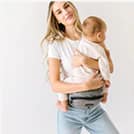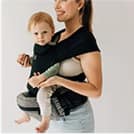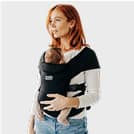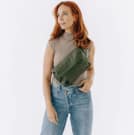What Are the Different Types of Baby Carriers?
Written by Connor Bringas on January 13, 2022.
Baby carriers are a fave among the new parent set because they make toting your tot a breeze – kind of. Some have lots of fabric, some have rings, and some have straps, but once you get the hang of it, baby carriers allow you to wear your baby on your body hands-free. That means you can scroll, zoom, and get your 10,000 steps in, all while wearing and snuggling your little one.
Each type of baby carrier also carries its own benefits: eye contact, sensory stimulation, social interaction, bonding, the list goes on. Babywearing promotes emotional and physical development, reduces crying, and promotes a sense of connection and comfort for your baby while you wear them! It also allows caregivers to easily accomplish day-to-day tasks while keeping their little one close and reducing hip and upper body strain.
Some parents like babywearing when their children are young, from birth to around six months; other parents wear their tots well into toddlerhood. It really comes down to personal preference. Before investing in a baby carrier, it might be a good idea to discuss your options and any safety concerns you have about babywearing with your pediatrician. Always read the manufacturer’s instructions before your first use, and be mindful of the activities you partake in while babywearing – (that means no yoga, no heavy lifting, and no cartwheels, please!).
There can be some trial and error in finding the carrier that works best for you — believe us, we’ve been there — so be patient with yourself and have some fun with it.
What are the different types of baby carriers?
You can’t go wrong with any baby carrier, but some styles might work better for you than others. There are four basic types of baby carriers:
Slings – Slings are typically made from a soft, breathable fabric that goes over one shoulder and across your torso like a sash. The design creates a pouch-like space for your baby to sit across your front. They’re not the best if you’re looking for even weight distribution, as slings can strain the wearer’s shoulders after long periods or be uncomfortable with back or shoulder pain. However, they’re great to have for beginners and breastfeeding: many parents love them for their womb-like simulation and snuggle effect, and babies do, too!
Wraps – Wraps are looong pieces of fabric that are configured around your body, usually over your shoulders and around your torso, to create a carrier. Both stretchy and woven wraps are pretty versatile: they can be worn over one or both shoulders, in the front or on your back. You might feel like you need a degree in origami to get the hang of it, but once you do, you’ll love the variety of ways to wear your baby. Make sure to read the manufacturer's instructions to ensure the safest fit for you and yours.
Structured – for those who don’t feel as confident with fabrics, structured carriers have shoulder straps and a thick, padded waistband to fasten around the wearer. With soft-structured carriers, the material creates a pouch for your baby, while more heavily structured carriers or backpacks often include a constructed seat. Structured carriers offer several carrying options that evenly distribute your child’s weight and support the wearer. They can be bulky and a bit pricey, but are great for growing children — and for active parents.
Hybrid Carriers – Some parents think hybrid carriers are the best of both worlds: they have the ease of a structured carrier while softly wrapping around your body with the closeness of a wrap. Hybrids tend to be easier to use and comfortable to wear, so they’re a great place to start when looking for a suitable carrier for your kid.
What's the difference between a sling and a baby carrier?
A baby sling is typically made from a piece of fabric worn over the shoulder and around your back like a sash, which creates a pouch in front for your baby to snuggle into. Some slings have rings attached for easy adjustments to create the best fit.
Compared to a sling, a baby carrier is more structured. They typically have shoulder straps, adjustable head support, and a designated seat for baby which evenly distributes their weight and allows for various carrying positions.
Do you really need a baby carrier?
As with everything baby-related, whether or not you need a baby carrier is truly a personal preference. Some parents prefer strollers for ease of use, while others like the bonding associated with baby carriers and the other benefits that babywearing offers.
Keep in mind that there’s no such thing as one size fits all when it comes to carriers. What works for your best friend, grandma, or even your partner may not work for you. Take the time you need to find your comfort level and go from there. As you can see, there are many options out there to choose from!
How do I choose a baby carrier?
Choosing the right baby carrier takes patience and practice. Start with whatever seems most manageable for your body and lifestyle, and let that be your guide! Many retail stores will let you try carriers on in-store and even train you on how to wear them. If you like to keep your shopping online, many manufacturers provide instructional videos and have trial periods for you to return your order within a specific time frame.
It never hurts to phone a fellow parent — see what’s worked for them and maybe they’ll let you test drive their gear. Above all, do what works for you while keeping your baby safe, and try to have some fun figuring it all out, too.
What is the best type of baby carrier and why?
Tushbaby is great for caregivers right from the start — it’s a streamlined hip seat baby carrier designed to support your back so you can carry your little one longer and more comfortably. Tushbaby puts your baby’s hips in the “M” position while reducing painful spine curvature in adults. It can be used as breastfeeding support in the early months, and transition to a face-to-face carrier once your baby has control of its head and neck. That’s when the fun begins!
And when it comes to schlepping your stuff, we got you: Tushbaby’s hip seat carrier doubles as a stylish fanny pack and diaper bag. Stash diapers and wipes in the storage beneath the seat, and keep your keys, phone, and wallet in the side pockets. You can even attach toys to the loops and tuck bottles in the holder — it's a win-win for everyone.
Tushbaby can be used for children up to 3 years old, or 45lbs.








Leave a comment